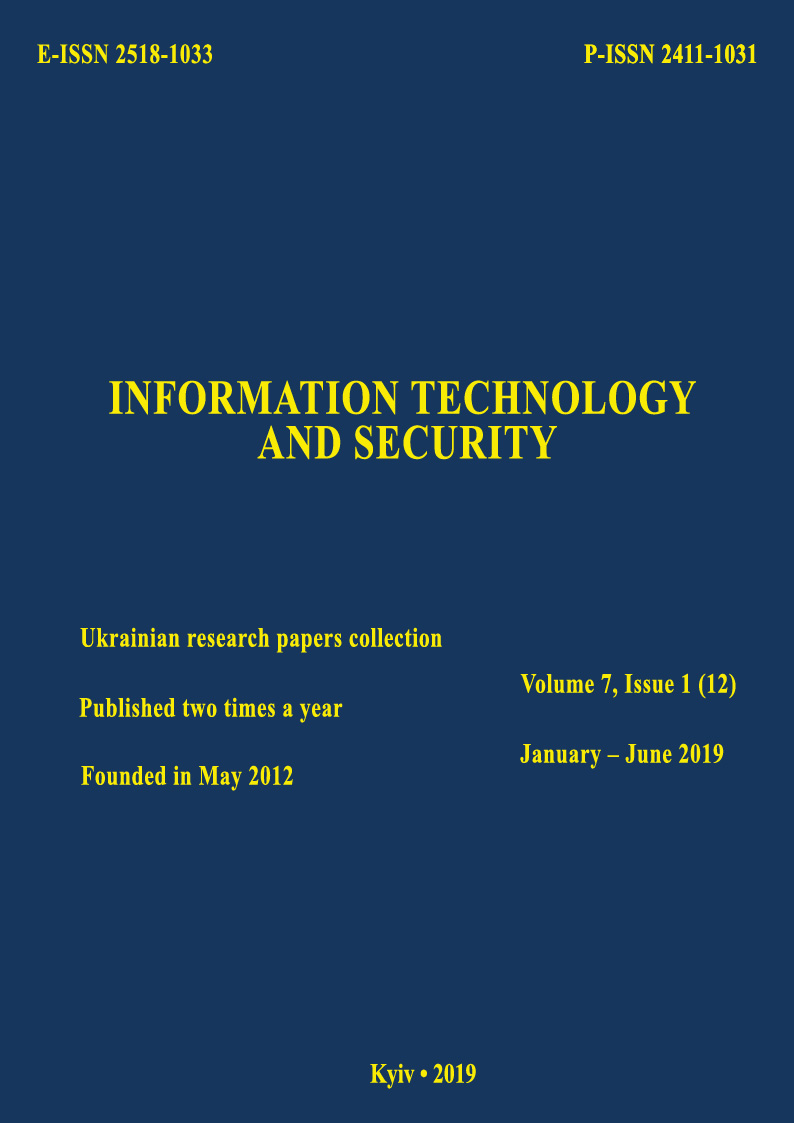Efficiency analysis of use atmospheric optical transmission systems
DOI:
https://doi.org/10.20535/2411-1031.2019.7.1.184397Keywords:
Atmospheric optical transmission systems, optical emitters, electromagnetic waves, lasers, event detection modelsAbstract
One of the scientific and technological progress characteristics at the beginning of the XXI century is the growing need for the processing, transmission, and preservation of various information types. The wideband and bimodality electromagnetic vibrations of the optical range, the visual perception availability, and the electrical neutrality of photons are best suited for the processing and transmission large amounts of information, including those presented in images and video. Examples of such systems are atmospheric (open) optical transmission systems. Their distinctive feature is the extremely high density of information in the channel and extremely high speeds of its transmission. For entering, processing, retransmission of data in atmospheric optical transmission systems, devices are required - analogs of super-high frequency functional devices but operating in the optical range with the amount of information and processing speed. The same level of technology is required for the processing of signals from radio-frequency systems, recognition systems, image recovery, and reading machines. Fiber-optic transmission system networks consist of active and passive components and devices (modules), through which information is transmitted. The last one has the form of the electric group (multichannel) signal in digital or analog transmission systems. This electric signal modulates one of the parameters (amplitude, frequency, phase, polarization, intensity) of the optical carrier oscillation, which can propagate in an optical fiber with a slight fading and form distortion. Under the component of the fiber-optic transmission system, we mean optics or optoelectronics product, designed to perform one or more functions in the formation, transmission, distribution, transformation, and processing optical signal. First of all, the components according to the principle of action can be divided into active and passive. Active components (modules) require an external power supply for their work), and passive ones are not. Examples of active components are radiation sources and receivers, transmitting and receiving devices, optical amplifiers, etc. Passive components such as optical fibers, connectors, filters, wave multi- and dimplexelectors and converters, splitters, valves, attenuators, reflectors, and others. An analysis of the parameters that determine the value of the possible energy potential of atmospheric optical transmission systems is carried out. The directions for increasing the reliability of atmospheric optical transmission systems due to the use of new optimization approaches are considered
References
O. M. Berdnikov, and A. V. Shcheryi, “Directions of increase of speeds of transmission of linear paths of telecommunication transport systems”, in Proc. XI International Scientific and Technical Conference Problems of Telecommunications, Kyiv, 2017, pp. 75-77.
T. M. Grynchyshyn, “Methods of digital processing of optical signals basedon the randomization procedure”, in Proc. 8-th science conference Mathematical Model of the Capasitive Accelerometer, Lviv, Slavske, 2005, pp. 140-143.
T. M. Grynchyshyn, “Methods of manipulation of signals in optical channels of communication”, in Proc. science conference Modern problems of radio engineering, telecommunications and computer, Lviv, Slavske, 2004, pp. 363-366.
T. M. Grinichyshyn, and Ya. M. Nikolaychuk, “Development of differential and bisignal methods for manipulating optical signals in open communication lines”, Bulletin of Technological University of Podillya, vol. 1, no. 3, pp. 121-124.
Ya. M. Nikolaychuk, Theory of sources of information. Тernopil, Ukraine: TNEU, 2008.
Y. I. Yaremenko, “Application of open optical transmission systems in communication networks”, Radioelectronics and telecommunications, no. 1 (37), pp. 35-42, 2005.
“Atmospheric Optical Transmission Systems”. [Online]. Available: http://www.micromax.ru/ catalog/comparePAV.shtml. Accessed on: Nov. 12, 2018.
“Fiber optic transmission systems”. [Online]. Available: http:// ndo.sibsutis.ru /magistr /courses work /vosp_work/ lectures_ index.htm. Accessed on: Nov. 12, 2018.
V. I. Korniychuk, I. B. Barba, and G. I. Doizha, “Analysis of the sensitivity of receiving devices VOSP-IBS”, Collection of scientific works ONAT them. O.S. Popov, no. 2, pp. 75-78, 2010.
S. Bloom, E. Korevaar, J. Schuster, and H. Willebrand, “Principles of FSO systems”, Journal of optical networking. vol. 2, no. 6, pp. 178-200, 2003. doi: 10.1364/JON.2.000178.
Downloads
Published
How to Cite
Issue
Section
License
Copyright (c) 2020 Collection "Information technology and security"

This work is licensed under a Creative Commons Attribution 4.0 International License.
The authors that are published in this collection, agree to the following terms:
- The authors reserve the right to authorship of their work and pass the collection right of first publication this work is licensed under the Creative Commons Attribution License, which allows others to freely distribute the published work with the obligatory reference to the authors of the original work and the first publication of the work in this collection.
- The authors have the right to conclude an agreement on exclusive distribution of the work in the form in which it was published this anthology (for example, to place the work in a digital repository institution or to publish in the structure of the monograph), provided that references to the first publication of the work in this collection.
- Policy of the journal allows and encourages the placement of authors on the Internet (for example, in storage facilities or on personal web sites) the manuscript of the work, prior to the submission of the manuscript to the editor, and during its editorial processing, as it contributes to productive scientific discussion and positive effect on the efficiency and dynamics of citations of published work (see The Effect of Open Access).

